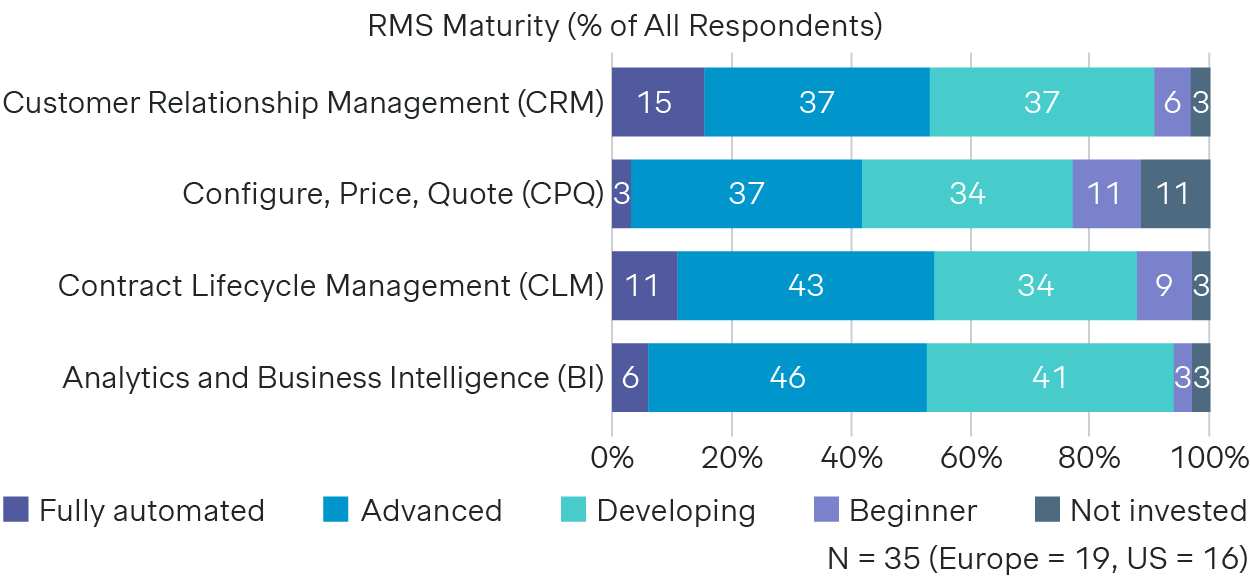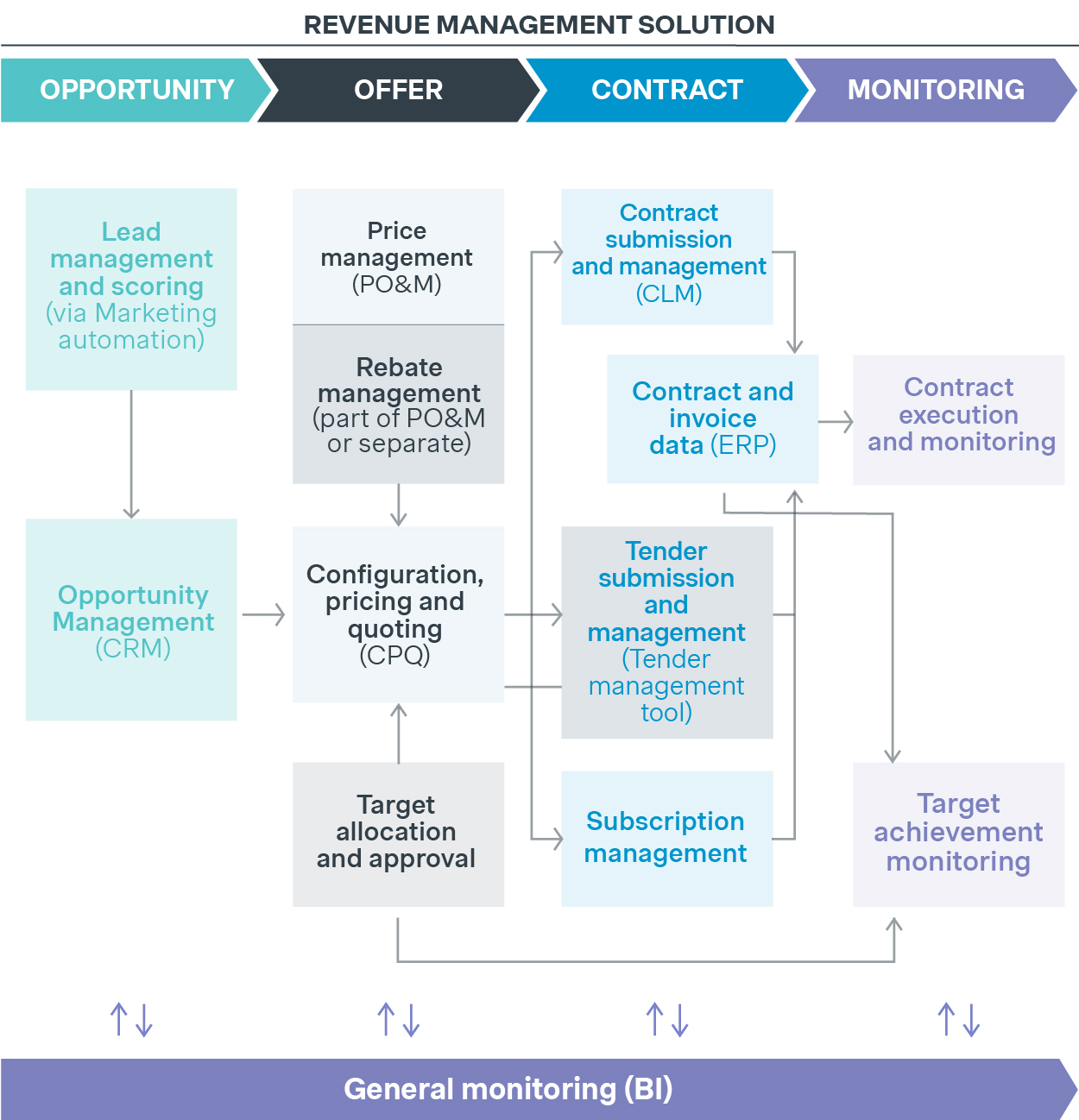The diagnostics sector is modernizing, but growth isn’t advancing at the same rate. Configure, price, quote (CPQ) often sits at the center of the problem. Notably, it is also the solution. Smarter CPQ integration within RMS can unlock faster quoting and deliver pricing that reflects real market value while ensuring reliable margins for better growth.
The diagnostics sector, under rising competitive pressure and changing customer needs, is being pushed to modernize its customer commercial infrastructures to manage increasing complexity. Additionally, fragmented data sources, varied competitor pricing structures, and differences in customer contracting preferences continue to create blind spots that erode profitability.
To better understand where the diagnostics sector stands in terms of Management Systems (MS), Simon-Kucher’s 2025 Global IVD Trend Study surveyed 35 stakeholders across the US and EU, focusing on Revenue Management Systems (RMS). We assessed four key areas: customer relationship management (CRM), configure, price, quote (CPQ), contract lifecycle management (CLM), and analytics and business intelligence (BI).

Source: Simon-Kucher Global IVD Trend Study 2025
The study highlights a clear maturity gap in diagnostics revenue management. CLM and CRM systems are the most developed domains, with roughly 10–15% of respondents reporting fully automated processes. In contrast, CPQ remains the least mature. Only 3% have full automation, while nearly half are still in early or developing stages.
Without the right systems in place, even well-intentioned commercial strategies can lead to misaligned pricing, inconsistent contract execution, and revenue leakage. Many diagnostics companies are already investing in RMS, but few capture the full value of these systems. In many cases, investments are undermined by reliance on manual processes or outdated systems which limits performance. The most successful companies take a holistic approach, aligning technology, processes, and people from the start. Yet, as survey results show, overall RMS maturity across the sector remains low.
Why diagnostics CPQ programs stall – and how to fix them
Understanding why CPQ maturity lags behind other components is critical to removing operational bottlenecks and for shaping a roadmap toward fully integrated RMS capabilities. While each company faces unique circumstances, a few structural challenges are common across most diagnostics companies.
1. Decentralized GTM models hinder CPQ standardization
As diagnostic companies expand across markets, many are left with fragmented commercial structures and localized pricing and quoting practices. With commercial ownership spread across regions and functions, CPQ processes vary significantly, making it difficult to apply consistent pricing logic, discounting rules, or customer segmentation frameworks.
Even leading companies can suffer from the effects of decentralization. In one example, a client managed much of their work through multiple Excel files circulating across business units and countries. This created constant inconsistencies, as no one could fully track how these spreadsheets were configured or maintained. Guided selling features (e.g., suggesting accessories when an instrument was added) were poorly designed, pricing guidance was missing, and important commercial considerations like time value of money or indexation clauses were often overlooked.
2. Partial CPQ solutions can blind users to downstream impact
Often companies adopt temporary CPQ solutions to gauge value and impact before committing to full-scale transformation. These pilots can deliver early wins but often create a false sense of progress. Seemingly small inefficiencies introduced early in the quoting stage ripple through the entire contract lifecycle.
Another leading diagnostics company tried this interim approach while still relying on manual approvals and outdated local tools. As a result, contracts often began with inconsistent or incorrect data. What appeared to be a minor issue at the outset later translated into billing discrepancies, untracked revenue allocations, and renewals that slipped through the cracks.
3. IT-first implementations fail to deliver expected CPQ value
Even companies that commit to a more comprehensive CPQ solution risk failure if implementation is mishandled. Many approach CPQ from a technology-first angle, deploying tools before defining a coherent quote-management framework. This leads to mismatches between local quoting practices and system design, resulting in costly workarounds and delayed deployments. Without alignment on core commercial processes, roles, and data flows, even the best CPQ platforms struggle to deliver the intended efficiency and commercial impact.
CPQ’s power comes from integration, not isolation

Source: Simon-Kucher
Closing the CPQ gap is a vital step toward preventing revenue leakage – but CPQ is not a standalone solution. It delivers full value only when connected with other components like CRM, CLM, and BI platforms to form a complete revenue management suite. Without alignment across these systems, the potential for accuracy, speed, and profitability is never fully realized.
RMS integration is where diagnostics profitability is won or lost. Here’s how each component fuels commercial excellence.
- CRM: Serves as the main input source for CPQ by providing critical customer data such as segmentation, history, and account activity. This ensures quotes are tailored to the specific context of each customer and grounded in up-to-date information. Without accurate CRM data, quoting processes quickly become inconsistent and misaligned with customer needs.
- CLM: Converts approved quotes into enforceable agreements. Integration with CPQ ensures consistency between what is proposed and what is contracted, minimizing rework and reducing errors across the sales-to-legal-to-operations handover.
- BI: Provides the analytical backbone of RMS by generating insights that inform pricing logic, customer segmentation, and deal performance. Feeding BI insights into CPQ and CRM helps ensure commercial decisions are not just operationally accurate, but also strategically optimized based on market and customer data.
When these systems work together, CPQ becomes a catalyst for margin improvement, enabling speed and commercial agility.
How we help build diagnostics-specific CPQ systems that deliver
Top diagnostics companies anchor their CPQ transformation within a broader revenue management strategy, built on data-driven and standardized processes across customer opportunities. This approach delivers quick wins compared to today’s fragmented practices, but it rarely achieves lasting impact on its own. Unless diagnostics-specific considerations and client nuances are embedded from the beginning, CPQ systems risk becoming harder to adapt and less effective in supporting long-term commercial goals.
At Simon-Kucher, we design diagnostics-specific CPQ frameworks that capture both the unique dynamics of the market and each client’s commercial reality. These frameworks are built for scalability, making them practical to implement, maintain, and adapt for changing business and market conditions. From past RMS enhancement projects, Simon-Kucher has achieved measurable impact – typically ~4% improvement in Return on Sales (RoS) and increased revenue for companies with higher RMS maturity
Stay tuned for additional diagnostics content as part of our Lab of the Future campaign. In the meantime, feel free to reach out to discuss CPQ and RMS in more detail.
FAQs:
1. What is a Management System?
A Management System is a structured framework of processes, tools, and governance practices that helps organizations plan, monitor, and continuously improve performance. In diagnostics, it brings structure to complex areas like quality assurance, operations, and commercial management.
2. How does a Revenue Management System fit in?
An RMS is a digital solution within that broader framework. It integrates CRM, CPQ, CLM, and BI to optimize pricing, forecasting, contracting, and quoting – each contributing unique value to the revenue process.
3. Why is CPQ so important?
CPQ directly connects commercial strategy to execution. It governs how diagnostics companies configure, price, and quote complex offerings. Done right, it reduces quote cycles, minimizes pricing errors, and improves margins.





